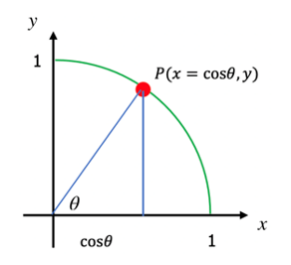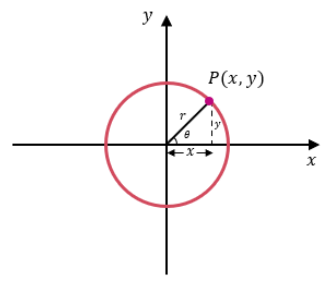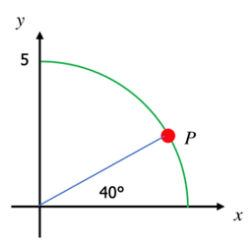5.2: Circular Trigonometry
- Page ID
- 125051
\( \newcommand{\vecs}[1]{\overset { \scriptstyle \rightharpoonup} {\mathbf{#1}} } \)
\( \newcommand{\vecd}[1]{\overset{-\!-\!\rightharpoonup}{\vphantom{a}\smash {#1}}} \)
\( \newcommand{\id}{\mathrm{id}}\) \( \newcommand{\Span}{\mathrm{span}}\)
( \newcommand{\kernel}{\mathrm{null}\,}\) \( \newcommand{\range}{\mathrm{range}\,}\)
\( \newcommand{\RealPart}{\mathrm{Re}}\) \( \newcommand{\ImaginaryPart}{\mathrm{Im}}\)
\( \newcommand{\Argument}{\mathrm{Arg}}\) \( \newcommand{\norm}[1]{\| #1 \|}\)
\( \newcommand{\inner}[2]{\langle #1, #2 \rangle}\)
\( \newcommand{\Span}{\mathrm{span}}\)
\( \newcommand{\id}{\mathrm{id}}\)
\( \newcommand{\Span}{\mathrm{span}}\)
\( \newcommand{\kernel}{\mathrm{null}\,}\)
\( \newcommand{\range}{\mathrm{range}\,}\)
\( \newcommand{\RealPart}{\mathrm{Re}}\)
\( \newcommand{\ImaginaryPart}{\mathrm{Im}}\)
\( \newcommand{\Argument}{\mathrm{Arg}}\)
\( \newcommand{\norm}[1]{\| #1 \|}\)
\( \newcommand{\inner}[2]{\langle #1, #2 \rangle}\)
\( \newcommand{\Span}{\mathrm{span}}\) \( \newcommand{\AA}{\unicode[.8,0]{x212B}}\)
\( \newcommand{\vectorA}[1]{\vec{#1}} % arrow\)
\( \newcommand{\vectorAt}[1]{\vec{\text{#1}}} % arrow\)
\( \newcommand{\vectorB}[1]{\overset { \scriptstyle \rightharpoonup} {\mathbf{#1}} } \)
\( \newcommand{\vectorC}[1]{\textbf{#1}} \)
\( \newcommand{\vectorD}[1]{\overrightarrow{#1}} \)
\( \newcommand{\vectorDt}[1]{\overrightarrow{\text{#1}}} \)
\( \newcommand{\vectE}[1]{\overset{-\!-\!\rightharpoonup}{\vphantom{a}\smash{\mathbf {#1}}}} \)
\( \newcommand{\vecs}[1]{\overset { \scriptstyle \rightharpoonup} {\mathbf{#1}} } \)
\( \newcommand{\vecd}[1]{\overset{-\!-\!\rightharpoonup}{\vphantom{a}\smash {#1}}} \)
The Sine Function on the Unit Circle
In computer games, objects typically move up-and-down and left-to-right. These movements can be produced using the sine and cosine functions.
Draw a circle with radius 1 unit and on its circumference, place a point, let’s call it \(P\).
The circle centered at the origin with radius 1 is called the unit-circle.

From our presentation of the sine and cosine function using right triangles, we can see that
\[\sin \theta=\frac{\text { opposite }}{\text { hypotenuse }}=\frac{y}{1}=y \nonumber \]
\[y=\sin \theta \nonumber \]
This tells us that the sine of the angle \(\theta\) determines the vertical distance of the point \(P\) from the horizontal axis.

The Cosine Function on the Unit Circle
To define cosine function, place a point \(P(x,y)\) on the circumference of unit-circle.
Once again, from our presentation of the cosine functions using right triangles, we can see that
\[\cos \theta=\frac{\text { adjacent }}{\text { hypotenuse }}=\frac{x}{1}=x \nonumber \]
\[x=\cos \theta \nonumber \]
This tells us that the cosine of the angle \(\theta\) determines the horizontal distance of the point \(P\) from the vertical axis.

The Sine and Cosine Functions on any Circle
We can extend this idea by making the radius of the circle \(r\) units rather than just 1 unit.

Using the same reasoning we just used with the unit circle, we see that
\[\sin \theta=\frac{\text { opposite }}{\text { hypotenuse }}=\frac{y}{r} \rightarrow r \cdot \sin \theta=y \rightarrow y=r \cdot \sin \theta \nonumber \]
\[\cos \theta=\frac{\text { adjacent }}{\text { hypotenuse }}=\frac{x}{r} \rightarrow r \cdot \cos \theta \rightarrow x=r \cdot \cos \theta \nonumber \]
which, again, tells us that the sine of the angle \(\theta\) determines the vertical distance of the point \(P\) from the horizontal axis and that the cosine of the angle \(\theta\) determines the horizontal distance of the point \(P\) from the vertical axis.
If \(P\) represents an object, that object’s height \(y\) off the ground (the horizontal axis) is given by \(r\cdot \sin \theta \), and that object’s horizontal distance \(x\) from some reference point is given by \(r\cdot \cos \theta \). The height of the object is controlled by some number \(r\) times \(\sin \theta\), and its horizontal distance is controlled by some number \(r\) times \(\cos \theta\).

An object lies on the circumference of a unit circle. Find its coordinates if the line segment from the origin to the object makes angle of 30° with the horizontal.
Solution

Because the object is on the circumference of unit circle, we can use
\(\begin{gathered}
x=r \cos \theta \text { and } y=r \sin \theta, \text { with } r=1, \theta=30 \\
x=1 \cos 30^{\circ} \text { and } y=1 \sin 30^{\circ} \\
x=\cos 30^{\circ} \text { and } y=\sin 30^{\circ} \\
x=0.8660 \text { and } y=0.5
\end{gathered}\)
The coordinates of the object are (0.8660, 0.5).
An object lies on the circumference of a circle of radius 5 cm. Find its coordinates if the line segment from the origin to the object makes angle of 40° with the horizontal.
Solution

Because the object is on the circumference of circle of radius 5 cm, we can use
\(\begin{gathered}
x=r \cos \theta \text { and } y=r \sin \theta, \text { with } r=5, \theta=40^{\circ} \\
x=5 \cos 40^{\circ} \quad \text { and } y=5 \sin 40^{\circ} \\
x=5(0.7660) \text { and } y=5(0.6428) \\
x=3.8302 \quad \text { and } y=3.2139
\end{gathered}\)
The coordinates of the object are (3.8302, 3.2139).
The coordinates of an object are (2.1, 3.6373). Find its distance from the origin.
Solution
We can use the Pythagorean Theorem, \(a^2+b^2=c^2\), where \(c\) is the hypotenuse, the radius of the circle in our case.
\(\begin{aligned}
& 2.1^2+3.6373^2=r^2 \\
& 4.41+13.2300=r^2 \\
& 17.64=r^2 \\
& \sqrt{17.64}=\sqrt{r^2} \\
& 4.2=r
\end{aligned}\)
We conclude that the object is about 4.2 cm from the origin.
Try these
An object lies on the circumference of a unit circle. Find its coordinates if the line segment from the origin to the object makes angle of 45° with the horizontal.
- Answer
-
(0.7071, 0.7071)
An object lies on the circumference of a unit circle. Find its coordinates if the line segment from the origin to the object makes angle of 5° with the horizontal.
- Answer
-
(0.9962, 0.0872)
An object lies on the circumference of a circle of radius 25 cm. Find its coordinates if the line segment from the origin to the object makes angle of 75° with the horizontal.
- Answer
-
(6.4705, 4.8396)
An object lies on the circumference of a circle of radius 10 feet. Find its coordinates if the line segment from the origin to the object makes angle of 135° with the horizontal.
- Answer
-
(-7.0711, 7.0711)
How high above the ground is an object that makes an angle of 60° with a 4-foot-tall observer’s eyes and is 35 feet away from that observer’s eyes? Round to two decimals place.

- Answer
-
34.31 ft
The coordinates of an object are (5.682, 2.0521). Find its distance from the origin if it makes an angle of 60° with the horizontal.
- Answer
-
6 units

